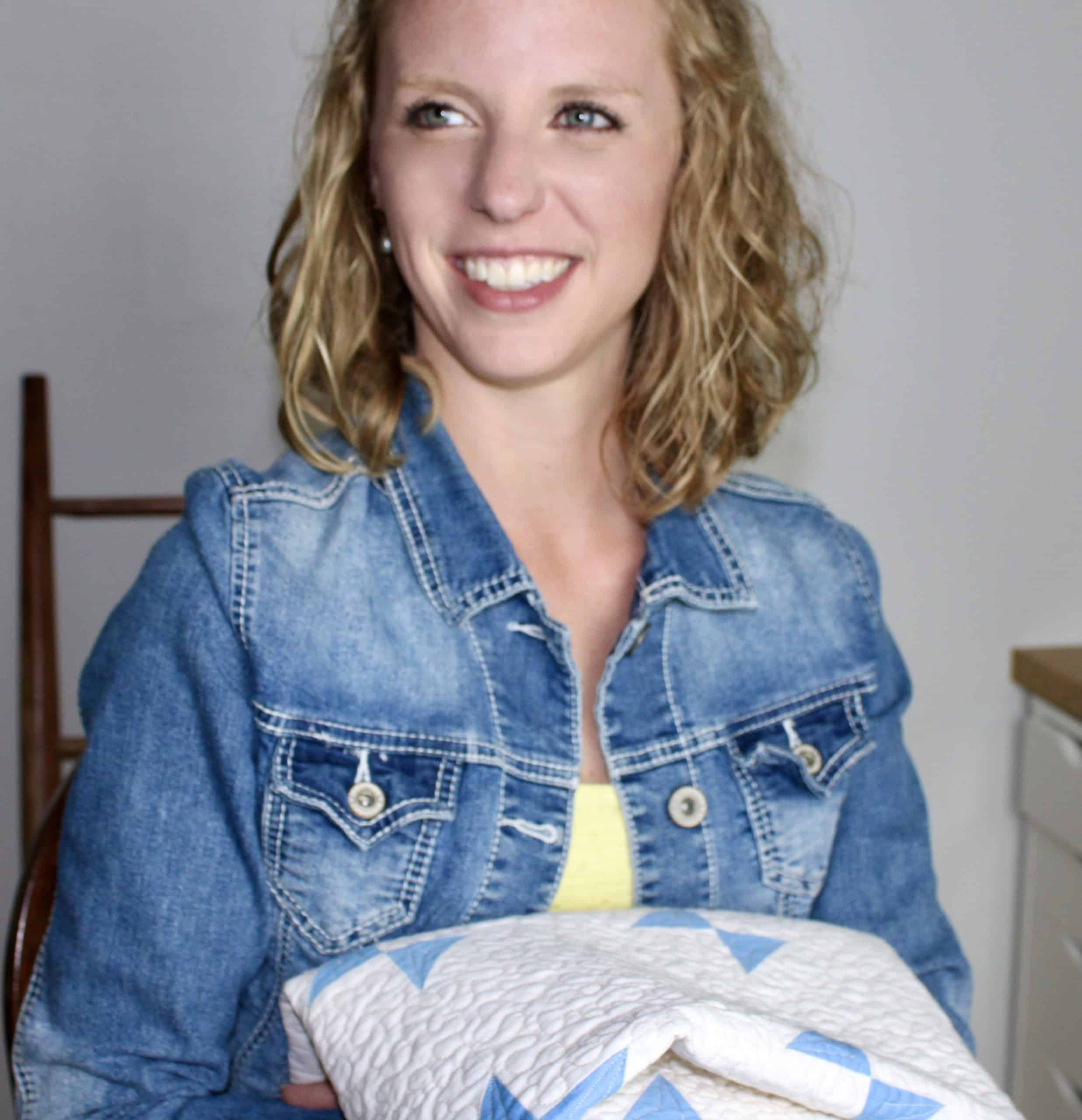Often considered a bare essential, a self-healing cutting mat usually makes it on the short list of supplies to get when you first get into the quilting hobby.
Self-healing typically refers to elasticity in the mat’s material which allows it to seal back up after using a rotary cutter on it and that quality can often come at a price.
So learning how to clean your cutting mat can go miles towards keeping it in great shape so you can get every penny out of it.

Ultimate cutting mat care tips
Fortunately for us, cutting mats are fairly low maintenance and only require a little help once in a while. The only things you really need to worry about when it comes to a cutting mat are these:
- Avoid cutting into the same lines over and over
- Clean the cutting mat as needed when fuzz builds up
- Moisturize the cutting mat every few months
- Store it properly
Related:
How to wash and care for a quilt
How to use a cutting mat to square fabric
How to clean and moisturize a cutting mat

Step 1: Remove fabric debris
This can be done in a variety of ways, many quilters use lint rollers, scrub brushes, sponges, or even a classic white eraser from grade school.
The goal is to remove the fuzz from being trapped in the cut marks of your mat. Whichever way you use to get the fuzz out really doesn’t matter, as long as the end goal is reached.
Removing the fibers out of the cutting mat allows the cuts to fully self-heal returning it back to a clean state where you shouldn’t be able to see any cut marks.
Once you’ve gotten the mat to the point where all of the fibers have been pull from the cut marks, gather any fuzz debris to the center of the mat and discard.
You should be left with a nice clean mat.
Step 2: Moisturize the mat

Take the mat to either a tub, shower, or sink, any place where it can fill with water while staying as flat as possible.
Fill up the tub or sink with cool water until its just enough to cover the mat, keeping track of how much water it is roughly filled with.
Note: It’s important to use cool water because hot, or even warm water, will give the mat just enough warmth to warp if not kept flat.
Once you have the tub or sink filled, add 1/4 cup of white vinegar for each gallon of water.
Let your mat sit in the diluted vinegar solution for about 15-20 minutes being careful that it is not warped or curved as much as possible.
Once the time has elapsed, using a soft bristle brush and a bit of dishwashing soap, gently scrub the surface of the mat.
The soap scrub should remove any residual fuzz, any discoloration from fabric dye, or ink marks while at the same time, restoring moisture to the elastic cutting surface.
Once you’ve finished the scrub, pat the cutting mat dry with a dish towel and leave the mat to air dry completely keeping it on a flat surface to prevent warping.
As soon as the mat has finished drying, return it to your normal storage location.
Cutting mat Storage suggestions/solutions

The life span of your cutting mat not only relies on how well it was cared for, but also how it was stored over time.
Poor storage locations of a cutting mat often lead to a cutting mat warping which often leaves the mat with inaccurate cutting lines and inaccurate quilt piece cutting.
The two biggest ways you can damage your cutting mat by storage are by storing it some place warm or hot, or storing it in any other condition than flat like rolling it up, or putting things on top of it that will bend it.
The worst of the worst locations combines both issues. Stored in a hot location where it is bent or rolled.
The average home usually is fine so long as you aren’t storing it above a radiator or in the hot trunk of a car, however there are some really great options out there to keep it in a flat state while being stored. Here are a few of favorites from around pinterest:
What happens when you don’t care for/clean your cutting mat
Multiple things can happen to your cutting mat if it is not cared for properly:
- Fuzz build up will create a bumpy surface underneath your fabric potentially giving you inaccurate cuts.
- Fuzz build up will distort your lines keeping you from seeing the exact line you want to cut on.
- A cutting mat that has lost moisture will slowly start to lose it’s self-healing properties and not bounce back any more (imagine a dried out rubber band)
- A dried out cutting mat is also more prone to cracking leaving it unusable to cut with
- If your cutting mat is stored improperly, it can become warped over time distorting the lines and causing it to be unusable for accurate cutting.
Why does fuzz build up on a cutting mat?

The “self-healing” properties of a cutting mat aren’t quite as they are advertised.
When you cut any type of fabric on your mat, it actually does slice into your mat, it’s just that the elastic rubber material bounces back and “seals” the cut up.
But when you cut fabric often enough, or cut batting on it often enough, you’ll notice the fuzz building up in those slices where you cut.
What’s happening is that when you cut into the cutting mat, you are forcing the fabric/batting fibers into the cut of the cutting mat with the rotary blade.
When the mat self-heals back into place, it embeds the fibers in the cut mark making a fuzzy surface on your mat.
Instead of trying to pick every single fiber out of the lines with your hands, using an eraser is a great easy (and quick) way to remove all of those fibers allowing the mat to fully self-heal where you won’t see those lines any more.
How to fix a warped cutting mat

This is a big “maybe” because depending on how badly your cutting mat is warped, it may not be salvageable.
Cutting mats typically distort because of one thing: heat.
If you have it stored incorrectly so it is bowed, and it is subjected to heat because it is near a heater in the house, or in the back seat of a car during the summertime, that shape it is sitting in will become its new permanent shape.
Why does that matter?
A bowed mat makes for inaccurate cutting simply because it won’t lay flat, and if you can get it to lay flat again, your mat’s lines may have also warped leaving you with the same issue.
You won’t know how bad it is until you try though, so step number one: unwarp it.
Your best bet to try and un-warp it, is to simply reverse the situation.
Apply heat to it, and attempt to flatten it back out.
One of the easiest ways to do this is to get a few towels and soak them in very hot water.
Put the mat on a flat surface and layer with the hot towels followed by as many layers of books as you can manage.
The towels will provide the heat to make it flexible again, and the books will train it back flat.
Leave the mat there for a couple of hours while the towels (and the mat) cool off permanently maintaining its shape.
Once the mat has (hopefully) been returned to a flattened state, you can figure out whether the lines have been affected by the warping or not.
To do this, all you need to do is simply compare the mat’s line measurements against a quilting ruler.
If everything checks out, quilt on. If not, you may have to consider replacing it.
When to replace a cutting mat
A cutting mat only needs to be replaced for one reason:
The lines on it are no longer usable.
This we’ve already mentioned a couple ways that this might happen, but a natural reason this might happen is simply because of use.
Depending on the size of the cutting mat that you purchase, there are only a handful of different lines available for you to use when you cut.
The more often you cut into a single line on the cutting mat, the more wear you are putting on that line.
It is common to find that you actually cut out chunks of the mat on those lines that you use consistently.
As the mat gets older, it will be harder and harder to retain that moisture and elasticity that keeps it self-healing. As the mat dries out, it will be more likely you see chunks get cut out.
While learning how to clean a cutting mat and moisturize it can definitely prolong the process eventually you will find it easier to simply replace.
Repurposing an old mat
All is not lost though, although it’s reached the end of it’s cutting mat career, your mat does not necessarily need to be thrown out.
There are plenty of other things that your retired mat can be used for in the sewing room, you’ll just have to get a little creative with it.
Here are a few of my favorite uses for a worn out cutting mat:
- Material to make templates out of
- Repurpose in other crafts (purse bottoms, hardcovers for books/kindles
- Use it as a sewing machine mat – place it under the sewing machine to absorb bouncing and prevent the machine from moving.
I’m sure there are plenty more that you’ll come across as well, so don’t hesitate to recycle it for your own needs! The landfill will thank you for it 🙂
Do you have any favorite uses for repurposing old cutting mats? Let me know in the comments below!
Stock up on our favorite cutting mats

I have seen plenty of pictures online of crazy collections of cutting mats in quilter’s sewing rooms.
Different sizes, different colors, the options are almost as endless as fabric options.
But of all the years that I’ve been quilting, I’ve only really found two (maybe three) that I recommend keeping around.
- 12”x18” rectangle
- A rotating cutting mat for block trimming
- (optional if you have a dedicated cutting area) the largest size you can fit on your surface
Olfa is typically my go to brand whenever possible. I love the quality of each of my cutting mats from them, and they definitely have one of the widest varieties of color options out there.
Pink, blue, white, navy, green, and that’s only some of the options. If you are at all looking to replace or add to your cutting mat collection, Olfa is my go to recommendation.
Perfect for even the smallest sewing areas, check out my favorite Olfa cutting mat here.









0 Comments